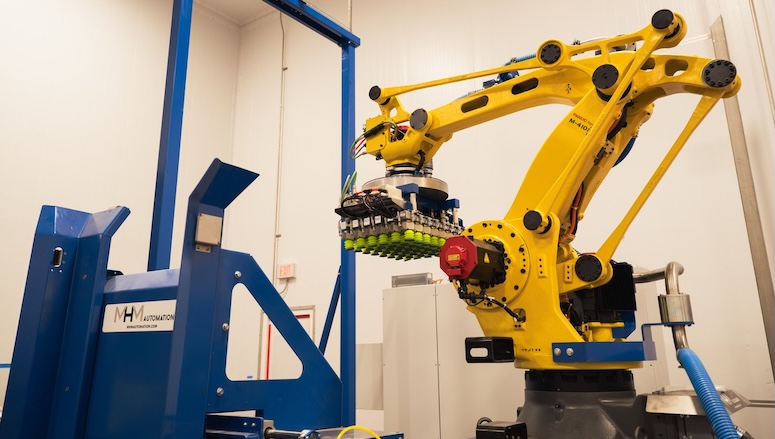— 9 min read
Mission Critical: Delivering on the Demand for Data Centers





Last Updated Jul 10, 2025

Sandra Benson
Sandra Benson is the Vice President of Industry Transformation at Procore Technologies. Sandra has an award-winning record of success in business process improvement utilizing technology for construction, engineering, real estate, and professional services firms. Sandra offers special expertise in creating operational strategies and business development, spearheading market expansion, and directing technology functions. Sandra brings over 30 years of experience in the Building and Building Technology industry holding a number of executive positions including Worldwide Head of Engineering, Construction and Real Estate at Amazon Web Services, CIO/VP at Kentz/SNC-Lavalin, Global Industry Director of E&C at J.D. Edwards/Oracle and at Hexagon PPM. She has worked with many global E&C, EPC, and real estate companies throughout her career. She is heavily involved in organizations that lead the way for technology advancement in the building industry and serves on the Board of Directors of the National Institute of Building Sciences as well as member of the Board of advisors for ViaTechnik. She is an advocate for women’s leadership. Sandra has been a featured speaker and author at many industry events. She was ConstrucTech Woman of the Year in 2014 and serves as a judge for this award.

Scott McKelvey
Contributing Writer
Scott McKelvey specializes in storytelling that creates moments of human connection. In addition to construction and technology, Scott has written about everything from medical devices and underwater robotics to fog machines and portable restroom trailers. He launched his full-time writing business in 2013 and moonlights as a dance dad, soccer dad, and theatre dad in Florence, New Jersey.

Steve Knighton
VP General Manager, Data Center Solutions
As VP General Manager of Data Center Solutions at Mortenson, Steve Knighton brings 25+ years of construction experience, overseeing projects from acquisition to completion, focusing on strategy, collaboration, and client satisfaction. He is DBIA and LEED AP accredited, and was honored in ENR’s 2015 Top 20 Under 40. He prioritizes providing teams with resources and support to deliver complex, mission-critical projects on time and within budget, working closely with regional GMs to ensure high standards and a seamless client experience through collaboration, innovation, and a commitment to value. Steve holds a BS in construction management and business management from Brigham Young University. He lives in Utah.

Nancy Novak
Chief Innovation Officer
As Chief Innovation Officer for Compass Datacenters, Nancy Novak is a leader in delivering sustainable, reliable, and mass-customizable data centers through cutting-edge technologies. With over 30 years of experience in the construction industry, she brings extensive expertise in strategic leadership, innovation, and operational management. Nancy is dedicated to disrupting the status quo in construction and championing women's leadership. She currently serves on the Executive Board of Directors for the National Institute of Building Sciences, the World Trade Center Institute, and Weston Solutions, a global environmental firm. She is also an executive sponsor for bridging the Digital Divide on the iMasons Advisory Board, advocating for equitable access to digital infrastructure. Nancy is the host of "Extending the Ladder," a podcast featuring dynamic conversations with accomplished women in technology, offering insights, advice, and inspiration. Her commitment to promoting women's leadership and driving impactful change in the construction industry through innovation is evident in her work and advocacy. Prior to her role at Compass, she held significant operational leadership positions with top-ranked construction contractors Hensel Phelps and Balfour Beatty. Nancy was recently honored as an inductee of the National Academy of Construction.

David Roberts
Chief Data Center Officer
As Chief Data Center Officer at MasTec, a $13 billion publicly traded infrastructure firm, David Roberts focuses on power, infrastructure, development, construction, and communications for data centers across North America. He has a track record of leading high-growth organizations, possessing deep experience across diverse sectors including data centers, industrial, sports, financial services, healthcare, telecommunications, infrastructure, office, technology, retail, and aviation. David brings extensive experience from T5 Data Centers, where he served as Senior Vice President, and from JLL, where he held various leadership roles including Executive Managing Director and Managing Director. His career began as a Project Director at Lend Lease and includes a notable role as Venue Development Manager for the Sydney Organising Committee for the Olympic Games (SOCOG). He holds an MBA from Macquarie Business School and a B.Arch in Architecture from the University of New South Wales (UNSW).
Last Updated Jul 10, 2025

Unprecedented growth in the data center market has created enormous pressure on industry stakeholders to keep pace. The need to quickly build hyperscale data centers to support modern applications demands a fresh approach to planning and managing these projects.
At Procore Groundbreak 2024, Sandra Benson, Vice President of Industry Strategy at Procore Technologies, moderated a panel that brought together senior executives from key stakeholder groups in the data center construction sector. Panelists included:
- Steve Knighton
Vice President, General Manager of Data Center Operations, Mortenson
Builder, developer and provider of energy and engineering services - Nancy Novak
Chief Innovation Officer, Compass Datacenters
Designer and builder of hyperscale and cloud data centers - David Roberts
Chief Data Center Officer, MasTec
Infrastructure construction company
In this article, we’ll provide a recap of this discussion, which provided multiple perspectives and unique insights into the drivers of data center growth, unique challenges in data center construction, innovative strategies for managing speed and scale and how to strike the right balance between rapid growth and sustainability.
Table of contents
What is driving data center growth?
There are two primary drivers of data center growth: Artificial intelligence (AI) and cloud computing. While cloud adoption has been growing steadily for years, AI adoption has skyrocketed virtually overnight.
“We saw AI building for a few years, but it has hit us like a tidal wave,” Nancy Novak said. “We need to learn how to pivot and change how we approach data center projects to accommodate demand.”
AI’s rapid growth has been well-documented. However, the business case for cloud computing that has existed for more than a decade ± cost-efficiency, scalability, agility and accessibility — continues to drive the adoption and expansion of cloud-based resources.
“Cloud is still growing at a healthy rate of 20 to 30 percent per year,” David Roberts said. “Now, we have this massive wave of AI, and we don’t know exactly how big that wave will be. We have to account for the foundation of cloud computing and the future-proofing of AI, which are different products that require different data centers.”
Another key factor in data center construction and density that must be addressed is power. Nancy pointed out that the U.S. has approximately 17 gigawatts of power availability, which must triple in the next decade to accommodate demand for AI and cloud computing. Achieving this goal would require an annual growth rate of about 50%.
What challenges are unique to data center construction?
The lack of a workforce is the primary obstacle to data center growth. This has ramifications that go beyond demand for AI and the cloud. In fact, the government has stated that a lack of digital infrastructure could become a national security crisis.
“We can’t press ‘pause’ on data center construction,” Nancy said. “There will be huge consequences for that. We have to figure out the workforce conundrum.”
The primary reason for the workforce shortage is the specialized expertise required to build a modern data center. Although a data center may look like a warehouse on the outside, a data center is built very differently for a much different purpose than any other commercial facility.
“You’re building a mission-critical system that’s designed to not go down,” Steve Knighton said. “As data centers become more advanced, the systems become more complex. An entire data center campus is built to operate like one chip, one processing unit. This can throw off contractors who typically start with steel and concrete. With a data center, you start with copper and electrons and flow outward until you build the box around it.”
David Roberts said a colleague who is an electrical engineer referred to today’s data center construction model as Revenge of the Nerds. Traditionally, a typical building had an 80-20 ratio between brick and mortar and mechanical, electrical and plumbing (MEP) systems. With a data center, the opposite is true. The increased emphasis on MEP systems changes procurement and project management.
The complexity of today’s data centers has also created a constantly moving target in terms of power, location, size, equipment, modularity and other variables.
“A couple years ago, I was working on [data center] jobs that were two acres with a building. In the blink of an eye, it went to 200 acres. Another was announced that will be 2,000 acres. The size growth in just a couple years is staggering," said David.
Strategies for Efficiently Managing the Speed & Scale of Data Center Construction
The need to quickly complete data center construction projects to meet demand for AI, cloud computing and other applications is forcing a change in data center construction contracting models and delivery mechanisms. Industry stakeholders must develop innovative strategies for overcoming labor shortages, increasing efficiency and agility and optimizing the supply chain.
“In a design-build model, everyone typically has what I call a mature set of bridging documents at the ready,” Nancy said. “We might look at design assist to site adapt, but we already have a product that we like and don’t want to break our footprint. Because of the speed to market, we have to buffer our schedule to order equipment out front.”
To meet aggressive construction deadlines, the general contractor must order equipment in advance and store it at a location that allows for efficient deployment to a project site when needed. As a result, the general contractor absorbs the cost of storing the equipment instead of paying a subcontractor’s markup.
At the same time, MEP labor represents the most significant risk at a data center construction project site. Data centers are often built where there is access to power, even if there is no labor force. In a design-build model, most labor risk shifts to the general contractor.
However, process integration among stakeholders and the manufacturing of data center components could help address speed and scale requirements, as well as labor shortages.
“We’re constantly looking for ways to remove work from the project site by creating integrated skids or manufacturing prefabricated components,” Steve said. “If we can manufacture lineups and send them to sites, we can get far ahead of that labor pinch. There are huge opportunities with the repeatability of a data center.”
A deeply coupled supply chain with close collaboration among developers, general contractors and specialty contractors is also essential to being able to keep projects on schedule and adapt to circumstances on the ground.
“We still need to be able to operate surgically on the jobsite,” Nancy said. “At Compass, we don’t spread our supply chain thin or look for other options when a partner can’t fulfill our wishes. We may seek to add partnerships to increase capacity, but with a deeply coupled supply chain, there’s a lot of loyalty involved.”
Given the heightened pressure for speed, scale and sustainability, demanding more from partners will only make the construction process more difficult.
“You can push harder on the gas, or you can reduce friction in the supply chain,” Steve said. “To work with the speed you need and reduce strain on the workforce, you have to carefully vet and choose your supply chain partners and bring everyone together. When you’re ready to hit ‘go’ on a project, your supply chain will be ready.”
Close collaboration will also help eliminate redundancy and unlock higher levels of return. Innovative organizations are embracing multi-trade integration and advanced technology platforms to capitalize on latent capacity for growth.
“The irony is that we think of data centers as highly complicated, but they’re simple in many ways,” David said. “It’s like a big industrial building with a Lego set inside. We have to rethink these projects and approach them differently.”
Stay updated on what’s happening in construction.
Subscribe to Blueprint, Procore’s free construction newsletter, to get content from industry experts delivered straight to your inbox.

Balancing Rapid Growth with Sustainability
Demand for hyperscale data centers while dramatically increasing access to power underscores the need for cleaner energy sources.
“We can’t just have Tier 2 diesel generators spewing hundreds of hours-worth of smoke in the air,” Nancy said. “We have to pivot from that, and there’s not one answer right now. In some places, you can’t get permits because generators don’t meet EPA standards, but if you use HVO (hydrotreated vegetable oil) fuel, you do help tremendously. Even when you find a new solution tomorrow, you’re still have thousands of generators burning diesel fuel. Steps have to be taken to address the backend and the future.”
When an audience member asked about small modular reactors (SMRs) as part of the power solution, panel members expressed cautious optimism about nuclear power.
“I think [nuclear power] is inevitable,” David said. “It’s fast, mobile and clean, and it generates a lot of power. There are a lot of positives but stigmas need to be overcome. There will be a tipping point. I’m not sure if that’s one, two or three years out. There has been smart money investment into SMR solutions and I think you’ll see regulations change, too.”
While cost and regulations are an obstacle to nuclear power adoption, the ability to recycle and reuse nuclear fuel rods can help overcome these hurdles.
“What gives me hope is recent permitting of recycled rods that are being turned into fuel,” Steve said. “This will allow us to recycle and reuse existing rods that are sitting around and generate carbon-free energy, which we badly need.”
Exciting Solutions for Exciting Times
Demand for building large, hyperscale data centers — and building them quickly — will only increase. Collaboration and openness to new models for solving today’s data center construction challenges are essential to meeting demand for growth. All three panelists are enthusiastic about what lies ahead.
“It’s exciting to be in an industry that’s literally building solutions that create solutions,” Steve said. “When you read about what AI can do in pharmaceuticals, healthcare and energy, this is the industry that builds the capability to solve these problems for humankind.”
“I love being on the tip of the spear for the Fifth Industrial Revolution because this is going to make lives better,” Nancy said. “Let’s focus on our workforce because the last thing AI is going to replace is the person with the tool in their hands. We need to help the construction industry get better, safer and more diverse.”
“I would just say to buckle up,” David said. “It's going to be a fast and furious ride, like nothing we have seen in our careers. There's going to be a very aggressive runway over the next eight to 10 years, possibly longer, and it's super exciting.”
this is part of the series
Groundbreak
Was this article helpful?
Thank you for your submission.
100%
0%
You voted that this article was . Was this a mistake? If so, change your vote
Scroll less, learn more about construction.
Subscribe to The Blueprint, Procore’s construction newsletter, to get content from industry experts delivered straight to your inbox.
By clicking this button, you agree to our Privacy Notice and Terms of Service.
Thank you!
You’re signed up to receive The Blueprint newsletter from Procore. You can unsubscribe at any time.
Categories:
Written by

Sandra Benson
Sandra Benson is the Vice President of Industry Transformation at Procore Technologies. Sandra has an award-winning record of success in business process improvement utilizing technology for construction, engineering, real estate, and professional services firms. Sandra offers special expertise in creating operational strategies and business development, spearheading market expansion, and directing technology functions. Sandra brings over 30 years of experience in the Building and Building Technology industry holding a number of executive positions including Worldwide Head of Engineering, Construction and Real Estate at Amazon Web Services, CIO/VP at Kentz/SNC-Lavalin, Global Industry Director of E&C at J.D. Edwards/Oracle and at Hexagon PPM. She has worked with many global E&C, EPC, and real estate companies throughout her career. She is heavily involved in organizations that lead the way for technology advancement in the building industry and serves on the Board of Directors of the National Institute of Building Sciences as well as member of the Board of advisors for ViaTechnik. She is an advocate for women’s leadership. Sandra has been a featured speaker and author at many industry events. She was ConstrucTech Woman of the Year in 2014 and serves as a judge for this award.
View profile
Scott McKelvey
Contributing Writer
Scott McKelvey specializes in storytelling that creates moments of human connection. In addition to construction and technology, Scott has written about everything from medical devices and underwater robotics to fog machines and portable restroom trailers. He launched his full-time writing business in 2013 and moonlights as a dance dad, soccer dad, and theatre dad in Florence, New Jersey.
View profile
Steve Knighton
VP General Manager, Data Center Solutions | Mortenson
As VP General Manager of Data Center Solutions at Mortenson, Steve Knighton brings 25+ years of construction experience, overseeing projects from acquisition to completion, focusing on strategy, collaboration, and client satisfaction. He is DBIA and LEED AP accredited, and was honored in ENR’s 2015 Top 20 Under 40. He prioritizes providing teams with resources and support to deliver complex, mission-critical projects on time and within budget, working closely with regional GMs to ensure high standards and a seamless client experience through collaboration, innovation, and a commitment to value. Steve holds a BS in construction management and business management from Brigham Young University. He lives in Utah.
View profile
Nancy Novak
Chief Innovation Officer | Compass Data Centers
As Chief Innovation Officer for Compass Datacenters, Nancy Novak is a leader in delivering sustainable, reliable, and mass-customizable data centers through cutting-edge technologies. With over 30 years of experience in the construction industry, she brings extensive expertise in strategic leadership, innovation, and operational management. Nancy is dedicated to disrupting the status quo in construction and championing women's leadership. She currently serves on the Executive Board of Directors for the National Institute of Building Sciences, the World Trade Center Institute, and Weston Solutions, a global environmental firm. She is also an executive sponsor for bridging the Digital Divide on the iMasons Advisory Board, advocating for equitable access to digital infrastructure. Nancy is the host of "Extending the Ladder," a podcast featuring dynamic conversations with accomplished women in technology, offering insights, advice, and inspiration. Her commitment to promoting women's leadership and driving impactful change in the construction industry through innovation is evident in her work and advocacy. Prior to her role at Compass, she held significant operational leadership positions with top-ranked construction contractors Hensel Phelps and Balfour Beatty. Nancy was recently honored as an inductee of the National Academy of Construction.
View profile
David Roberts
Chief Data Center Officer | Mastec
As Chief Data Center Officer at MasTec, a $13 billion publicly traded infrastructure firm, David Roberts focuses on power, infrastructure, development, construction, and communications for data centers across North America. He has a track record of leading high-growth organizations, possessing deep experience across diverse sectors including data centers, industrial, sports, financial services, healthcare, telecommunications, infrastructure, office, technology, retail, and aviation. David brings extensive experience from T5 Data Centers, where he served as Senior Vice President, and from JLL, where he held various leadership roles including Executive Managing Director and Managing Director. His career began as a Project Director at Lend Lease and includes a notable role as Venue Development Manager for the Sydney Organising Committee for the Olympic Games (SOCOG). He holds an MBA from Macquarie Business School and a B.Arch in Architecture from the University of New South Wales (UNSW).
View profileExplore more helpful resources

Harnessing Smart Construction Technology for Future Growth
Augmenting human intelligence with smart technology in construction makes it possible to tackle the considerable challenges of building the structures society demands. To adapt to client expectations while maintaining profitability,...

Mastering Capital Project Risk Management Across the Project Lifecycle
Capital projects — construction of significant infrastructure such as highways, utilities, or large-scale structures like hospitals or office buildings — have long timelines and with longer construction time comes greater...

Automation in Construction: Transforming the Future of Building
Technological advancements empower the construction industry to tackle complex projects and drive the global demand for sustainable, feature-rich structures technology makes possible. From design to closeout, construction automation is enabling...

Bid Management Software: Key Features & How to Choose the Right Fit
Bidding on construction projects can be a complex process. Sourcing appropriate bids and requests for proposals, analyzing bid documents, making sure estimates, preliminary schedules, and other mandatory requirements are met...
Free Tools
Calculators
Use our calculators to estimate the cost of construction materials for your next project.
Templates
Find a template to help you with your construction project tasks.
Material Price Tracker
Get the latest U.S. retail prices and view historical trends for common building materials.
Glossary
Explore key terms and phrases used in the industry.
